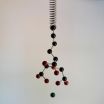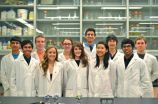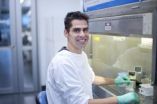(Press-News.org) Fraudsters beware: the more your social networks connect you and your accomplices to the crime, the easier it will be to shake you from the tree.
The Steiner tree, that is.
In an article recently published in the journal Computer Fraud and Security, University of Alberta researcher Ray Patterson and colleagues from the University of Connecticut and University of California – Merced outlined the connection linking fraud cases and the algorithm designed by Swiss mathematician Jakob Steiner. Fraud is a problem that costs Canadians billions of dollars annually and countless hours of police investigations. Patterson says that building the algorithm into fraud investigation software may provide important strategic advantages.
The criminal path of least resistance
To quote a television gumshoe, everything's connected. Figuring out who knows who and who has access to the money is like playing a game of connect-the-dots. Patterson says that for crimes like fraud, the fewer players in the scheme, the more likely it will be accomplished. Maintaining a small group of players is also what links it to the Steiner tree. He says that by analyzing various connecting social networks—email, Facebook or the like—finding out the who, what and how of the crime can be boiled down to numbers.
"You're really trying to find the minimum set of connectors that connect these people to the various [network] resources," he said. "The minimum number of people required is what's most likely to be the smoking gun. You can do it with math, once you know what the networks are."
Fraud and the Steiner tree, by the numbers
In their article, Patterson and his colleagues explored how networks such as phone calls, business partnerships and family relationships are used to form essential relationships in a fraud investigation. When these same relationships are layered, a pattern of connection becomes obvious. Once unnecessary links are removed and false leads are extracted, the remaining connections are most likely the best suspects. Patterson says that finding the shortest connection between the criminals and the crime is the crux of the Steiner tree.
"All of these things that we see in life, behind them is a mathematical representation," said Patterson. "There are many, many different algorithms that we can pull off a shelf and apply to real-life problems."
A potential tool for the long arm of the law?
Patterson says that with the amount of work that could potentially go into investigating a fraud case, such as obtaining warrants for phone or email records, and identifying and interviewing potential suspects, developing a program that uses a Steiner tree algorithm may save a significant portion of investigators' time—time that, he says, could likely be reallocated to backlog or cold case files. "If you can reduce your legwork by even 20 per cent, that has massive manpower implications. I think algorithms like this one could help you reduce your legwork a lot more than that," he said.
Although there is software that police and other law enforcement agencies can use to solve fraud, Patterson sees no evidence that those programs use a Steiner tree algorithm, something he says would bring some structure to an unstructured area. He hopes programmers and investigators will take note of the findings and make changes to their practices.
"It might take several years or many years before anyone picks it up," said Patterson. "But it's a good thing if we can point people towards what's useful."
### END
Math tree may help root out fraudsters
Applying algorithm to social networks can reveal hidden connections criminals use to commit fraud, says UAlberta researcher
2012-09-06
ELSE PRESS RELEASES FROM THIS DATE:
Forcing the molecular bond issue
2012-09-06
Material properties and interactions are largely determined by the binding and unbinding of their constituent molecules, but the standard model used to interpret data on the formation and rupturing of molecular bonds suffers from inconsistencies. A collaboration of researchers led by a scientist at the U.S Department of Energy (DOE)'s Lawrence Berkeley National Laboratory (Berkeley Lab) has developed a first-of-its-kind model for providing a comprehensive description of the way in which molecular bonds form and rupture. This model enables researchers to predict the "binding ...
Pint-size microRNAs show promise against weighty problem, researchers say
2012-09-06
Tiny strands of RNA affect how our cells burn fat and sugar — a finding that gives biologists a place to start in the quest for therapies to treat obesity and related health problems, said scientists at Virginia Tech and the University of Texas Southwestern Medical Center at Dallas.
Mice on high fat diets are resistant to obesity when two mini-molecules called microRNAS are missing from their genetic makeup, according to a study this week in the Proceedings of the National Academy of Science
The discovery suggests that treatments targeting these two specific microRNAs ...
University of Hawaii cancer researchers discover gene defect responsible for cancer syndrome
2012-09-06
HONOLULU, HI - University of Hawai'i Cancer Center researchers have discovered germline BAP1 mutations are associated with a novel cancer syndrome characterized by malignant mesothelioma, uveal melanoma, cutaneous melanoma and atypical melanocytic tumors. Germline mutations are hereditary gene defects that are present in every cell.
The study investigated two unrelated families with BAP1 defects and found an increase in the occurrence of mole-like melanocytic tumors that are non-cancerous flat or slightly elevated and pigmented skin lesions. These benign skin lesions ...
Students create low-cost biosensor to detect contaminated water in developing nations
2012-09-06
TEMPE, Ariz. – Diarrheal disease is the second leading cause of death in children under five years old — killing as many as 1.5 million children worldwide every year. These startling statistics from the World Health Organization (2009) point to the reason why a group of undergraduate students from Arizona State University is working to develop a low-cost biosensor — a simple device that would detect contaminated drinking water.
An interdisciplinary team of nine students is participating in the 2012 International Genetically Engineered Machine (iGEM) competition — a prestigious ...
Moderate voices muted in political news
2012-09-06
Los Angeles, CA (September 6, 2012) While commentators and scholars argue that political groups have become more polarized in the US, a new study finds that moderate political groups are not as well covered in newspaper articles as more radical right and left-wing groups. This study is found in a recent article from Journalism & Mass Communication Quarterly, a SAGE journal and an official journal of the Association for Education in Journalism and Mass Communication.
"Extremes are more intuitively novel, entertaining, and colorful, representing another common news value," ...
Stem-cell-protecting drug could prevent the harmful side effects of radiation therapy
2012-09-06
Radiation therapy is one of the most widely used cancer treatments, but it often damages normal tissue and can lead to debilitating conditions. A class of drugs known as mammalian target of rapamycin (mTOR) inhibitors can prevent radiation-induced tissue damage in mice by protecting normal stem cells that are crucial for tissue repair, according to a preclinical study published by Cell Press in the September issue of the journal Cell Stem Cell.
"We can exploit the emerging findings for the development of new preventive strategies and more effective treatment options ...
Immune cell death safeguards against autoimmune disease
2012-09-06
Researchers at the Walter and Eliza Hall Institute have discovered that a pair of molecules work together to kill so-called 'self-reactive' immune cells that are programmed to attack the body's own organs. The finding is helping to explain how autoimmune diseases develop.
Dr Daniel Gray and colleagues from the institute's Molecular Genetics of Cancer division and the University of Ballarat discovered that the absence of two related proteins, called Puma and Bim, led to self-reactive immune cells accumulating and attacking many different body organs, causing illness. The ...
A family portrait of galaxies
2012-09-06
6 September 2012: Two very different galaxies feature in this family portrait taken by the NASA/ESA Hubble Space Telescope, together forming a peculiar galaxy pair called Arp 116. The image shows the dramatic differences in size, structure and colour between spiral and elliptical galaxies.
Arp 116 is composed of a giant elliptical galaxy known as Messier 60, and a much smaller spiral galaxy, NGC 4647.
Being a typical elliptical galaxy, Messier 60 on its own may not be very exciting to look at, but together with its adjacent spiral friend, the pair becomes a rather interesting ...
Novel therapeutic targets identified for small cell lung cancer
2012-09-06
PHILADELPHIA — Newly discovered molecular differences between small cell lung cancer and nonsmall cell lung cancer have revealed PARP1 and EZH2 as potential therapeutic targets for patients with small cell lung cancer, according to the results of a study published in Cancer Discovery, a journal of the American Association for Cancer Research.
Currently, small cell lung cancer accounts for about 15 percent of lung cancer diagnoses in the United States. Patients with the disease will initially respond to chemotherapy, but almost all will have disease recurrence within a ...
Master gene affects neurons that govern breathing at birth and in adulthood
2012-09-06
HOUSTON - (Sept. 7, 2012) – When mice are born lacking the master gene Atoh1, none breathe well and all die in the newborn period. Why and how this occurs could provide new answers about sudden infant death syndrome (SIDS), but the solution has remained elusive until now.
Research led by Baylor College of Medicine and the Jan and Dan Duncan Neurological Research Institute at Texas Children's Hospital demonstrates that when the gene is lacking in a special population of neurons called RTN (retrotrapezoid nucleus), roughly half the young mice die at birth. Those who survive ...
LAST 30 PRESS RELEASES:
Novel endocrine therapy giredestrant improves disease-free survival over standard of care for patients with early-stage breast cancer in phase III lidERA trial
Gen Z views world as "scary place" with growing cynicism about ability to create change
Biosensor performance doubled – New applications possible
Leveraging incomplete remote sensing for forest inventory
Key chemical in dark chocolate may slow down ageing
New 15-minute hepatitis C test paves the way for same-day treatment
Uranus and Neptune might be rock giants
Magnetically actuated soft electrodes for multisite bioelectrical monitoring of ex vivo tissues
FAU engineers decode dementia type using AI and EEG brainwave analysis
Carrier-free peptide–daunorubicin–small interfering RNA nanoassembly for targeted therapy of acute myeloid leukemia
Global Virus Network announces appointment of new board members
Artificial beaver dams show promise in offsetting climate change effects
Could hidden infections be fueling long COVID?
Targeted oxygen for initial resuscitation of preterm infants
Researchers develop models to help diagnose ALS earlier through blood biomarkers
Jeonbuk National University researchers develop novel eco-friendly and photo-switchable smart adhesives
Magnetic ordering induces Jahn–Teller effect in spinel-type compounds
A mitochondrial protein may hold the secret to longevity, new study finds
Study shows how everyday repairs sustain autonomy in a Japanese squat
Ancient manatee relative reveals that sea cows have engineered the Arabian Gulf’s seagrass ecosystems for over 20 million years
Fecal tests reveal active termite attacks
Uterine fibroids linked to elevated heart disease risk
Dual use of cigarettes and vapes can reduce risks of smoking and help smokers quit
New bioelectronics device based on hydrogel- elastomer conductive nanomembranes
More yield through heterosis: IPK research team decodes gene interaction
James Webb telescope reveals spectacular atmospheric escape
ICE-CSIC leads a pioneering study on the feasibility of asteroid mining
Dramatic rise in young people using mental health services
Be careful trusting TikTok for gout advice
A study by the University of Seville links the vanishing of the specific heats at absolute zero with the principle of entropy increase
[Press-News.org] Math tree may help root out fraudstersApplying algorithm to social networks can reveal hidden connections criminals use to commit fraud, says UAlberta researcher



